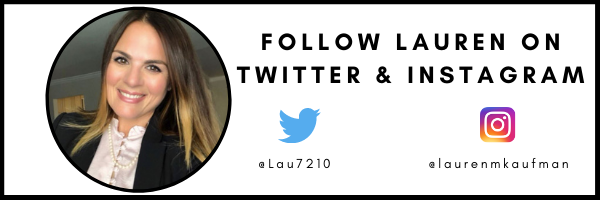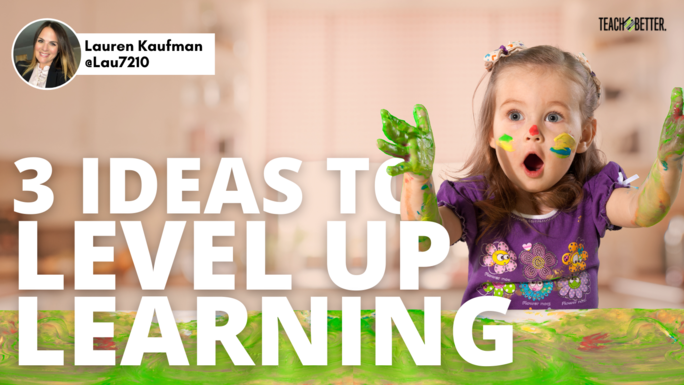TL;DR:
- Educators have the opportunity to impact and influence every learner by unlocking their unlimited potential. Learners must have a strong connection with their teachers first before they can feel empowered to engage in deep learning.
- There are 3 ways to level up learning:
- Tell personal stories that share who you are and your why.
- Build bridges by asking questions, sharing feelings, and moving to build a connection from the heart to the mind.
- Cultivate connections by collecting information through online surveys, 5-minute meetings, and 1:1 conferences.
Embrace the Opportunity
Educators have been afforded a magical opportunity to impact and influence the lives of every learner they encounter throughout their careers. There is no doubt in my mind that this is a tremendous responsibility that rests on the shoulders of every interaction and experience we shape on the journey. You see, education is not just a career, it’s a calling. It’s a chance to create memorable moments that touch hearts, inspire learners to dream, and provide them with purposeful supports as they manifest their hopes for the future. Educators have the power to level up learning—to create spaces of psychological safety and tap into the emotional drive that will propel learners toward success. They have the ability to leverage intentional dialogue in their environments, provide learners with equitable access to their education in meaningful ways, and establish a sincere set of values and beliefs they can continuously put into action.
This is a belief system that will model high levels of integrity and commitment to those they serve. In the book Unlocking Unlimited Potential by Dr. Brandon Beck, he beautifully states, “It’s the ultimate goal of all educators to unlock the unlimited potential in all whom you serve… your purpose as an educator has to involve your belief that you can guide all students to understand their potential is unlimited” (pp. 6-7).
Moving Beyond Our Locus of Control
Amidst a global pandemic, educators have been faced with challenges that are beyond their locus of control. According to the article, Locus of Control and Your Life by Kendra Cherry, “Locus of control refers to the extent to which people feel that they have control over the events that influence their lives.” People who have an external locus of control don’t believe they can change despite their efforts. This has placed insurmountable pressure on educators who prefer to be in control of all of their professional outcomes and may believe that they must cover all of the standards and content in order for learners to be successful.
However, the article continues to say that people who have a strong internal locus of control have more confidence when they are faced with challenges and have a strong sense of self-efficacy to be flexible and embrace change while reimagining learning in the new educational landscape we are living in. This has made educators question how they are going to unleash the talents in every learner that enters their learning spaces. If we are asking learners to engage in various learning activities in physical and virtual spaces, take risks, and put forth effort while embracing the infinite mindset, shouldn’t educators be modeling the same actions?
Where Do We Invest Our Time?
That being said, there have been various barriers including a lack of continuity of instruction that has gotten in the way of the engagement and empowerment learners need to thrive. In the book Learner Centered Innovation: Spark Curiosity, Ignite Passion, and Unleash Genius by Katie Martin, she asks the following questions: “Why do some students willingly engage in academic tasks? What makes learners persist in challenging tasks? What compels learners to want to learn more and improve?” (p. 76). Martin goes on to talk about Camille Fallington’s deep research about creating cultures that develop mindsets for deeper learning to occur. “The following mindsets have been identified as critical to student motivation and willingness to persist in academically challenging work.
I belong in this community. I can succeed at this. My ability and competence grow with effort. My work has value to me.
…As learners, teachers, and leaders, we must cultivate and model these mindsets too” (pp. 76-77). Throughout my teaching experiences, I have come to realize that before learners are able to feel empowered to engage in deep learning, educators must make an investment in the emotional deposit box by developing strong connections. In Unlocking Unlimited Potential, Dr. Beck brilliantly states, “It starts with educating students from the inside out in order to find the Sweet Spot” (p.48). So I ask, how can educators level up learning to create relevant, meaningful learning experiences that will leave an everlasting impact on the hearts and minds of the students they serve?
Throughout my teaching experiences, I have come to realize that before learners are able to feel empowered to engage in deep learning, educators must make an investment in the emotional deposit box by developing strong connections. Click To Tweet
Here are 3 Ideas to Level Up Learning
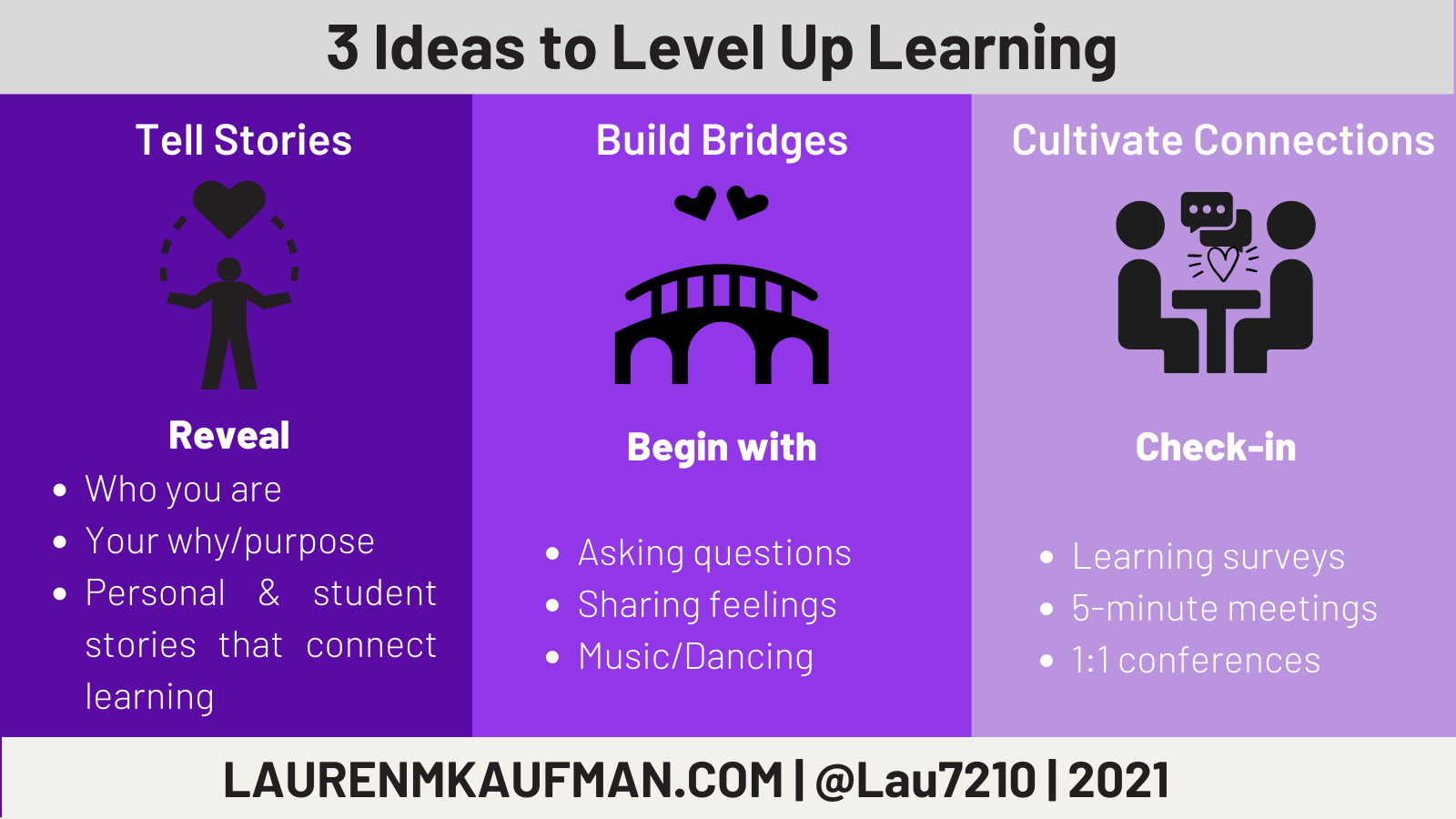
Level Up Learning #1: TELL STORIES
Stories are windows into our experiences. They are small moments etched into our memories. They are the ammunition that pushes us down the path of discovery. In an #InnovatorsMindset podcast, George Couros says “Stories are the fuel for innovation, they inspire us, they give us pertinent ideas, they get the work we are doing out to people in a really compelling way that goes beyond what a score could tell people about our students.” Beneath the façade of every human being lies personal, unique collections of stories that reveal reflections of who they are and who they want to be. How can we intentionally create spaces for learners to share how they view the world through stories?
REVEAL WHO YOU ARE
- Tell YOUR story and share the reason your journey led you to where you are right now! We all come from various experiences that shape who we are. By sharing those experiences, you are showing learners that they have the power to write their own narratives and change their course as they evolve as human beings!
REVEAL YOUR WHY/PURPOSE
- There is nothing more powerful than telling your learners why you were placed in a position to teach them how to maximize their social, emotional, and academic potential. Simon Sinek says, “People don’t buy what you do, they buy why you do it…there are leaders and those that lead. We follow those who lead, not for them, but for ourselves. Those who start with their ‘why’ have the ability to inspire those around them.” What we value and how we share “why” we value those things, changes the culture of the classroom/building.
REVEAL PERSONAL AND STUDENT STORIES THAT CONNECT LEARNING
- In Richard Gerver’s book Change, he notes that people can “Use stories as tools to build momentum in others.” Sharing educator and student stories will inspire the learning community to have empathy and understanding for one another. Stories are real-world examples that can breathe meaning and life into learning. That authentic connection can give the content more meaning and motivate learners to see its value and build a deeper understanding of the classroom community and curriculum.
Level Up Learning #2: BUILD BRIDGES
According to the Merriam Webster Dictionary, one of the definitions of a bridge is, “a time, place, or means of connection or transition.” One of our critical roles as educators is to help learners build bridges that connect the heart to the mind. Throughout this journey, we are learning and thinking partners who provide the right scaffolds that help learners walk across the bridge with intention and purpose and grasp the new learning that exists on the other side.
However, it’s the actual process of walking on the bridge, the productive struggle, those moments where as educators, we get to say, “I’m here for you, I care about you, and let’s have fun while doing it!” that will nurture the heart and make it easier for learners to open their minds.
BEGIN WITH ASKING QUESTIONS
- When beginning a class in virtual and/or physical spaces, I have found that asking questions to launch a lesson and/or embedding them over the course of the day will set a positive tone for learning. I have asked questions as simple as “If you can eat one food for the rest of your life, what would it be and why? Who is someone that has been an inspiration to you and why? What are the 3 most important things in your life, why?”
- I also love “Would You Rather” questions such as “Would you rather be invisible or fly, why? Would you rather be Batman or Spider-Man, why? Would you rather fly around the world for free for the rest of your life or eat at any restaurant you want for free?” Learners can respond orally, in the live chat, or in a digital tool such as Google Jamboard or Mentimeter. These questions are a fun way to connect and the classroom community gets to learn more about one another.
BEGIN WITH SHARING FEELINGS
- A critical part of being an educator is checking in on your learner’s emotional state. It is an opportunity to “read the room” and see where learners’ hearts and minds are during their time with you. In Unlocking Unlimited Potential, Dr. Beck states, “…it should be the unspoken truth in all schools that understanding your students’ emotions first and foremost is at the forefront of everything you do” (p. 49). He goes on to say, “Students are not robots programmed with all of the same software, they have many different dimensions and unique identities. Not providing SEL opportunities consistently is equivalent to trying to fly a plane without an engine. You aren’t going anywhere fast” (p. 51). It is a good idea to provide learners with emotional language to support them in expressing their feelings.
BEGIN WITH MUSIC/DANCING
- One of the best parts of the day is when I incorporate music and dancing into learning. Sometimes it is music that I choose and other times I let my learners be the DJ. Moving and listening to music creates a fun, light-hearted space. This opens learners up to tackling the skills and strategies that will be taught that day. In a CNN article by Kelly Wallace, titled Move over, ‘sit still’! Why kids need to move in school, Dr. John Ratey, an associate clinical professor of psychiatry at Harvard Medical School, says “When you move, you stimulate all the nerve cells that we use to think with, and when you stimulate those nerve cells, it gets them ready to do stuff.”
Level Up Learning #3: CULTIVATE CONNECTIONS
The heart of teaching and learning is rooted in the connections and relationships we develop with the learners we are lucky enough to serve. Cultivating strong relationships, understanding the learners’ strengths and areas for growth, tapping into their passions and interests, and providing equitable access to the curriculum for ALL learners are cornerstones to any worthwhile educational journey.
In a recent Equity in Education Panel at #NCTIES2021, Sean Gaillard shared his working definition of equity, “Limitless opportunities for all-ALL the time…it’s relentless, it’s sustainable.” Without truly caring about the social-emotional well-being of every student, learning will not be as productive or meaningful. If we want to see the positive, lasting impact we are hoping for, we have to make it our obligation to get to know all learners as human beings first and give them what they need to thrive.
[scroll down to keep reading]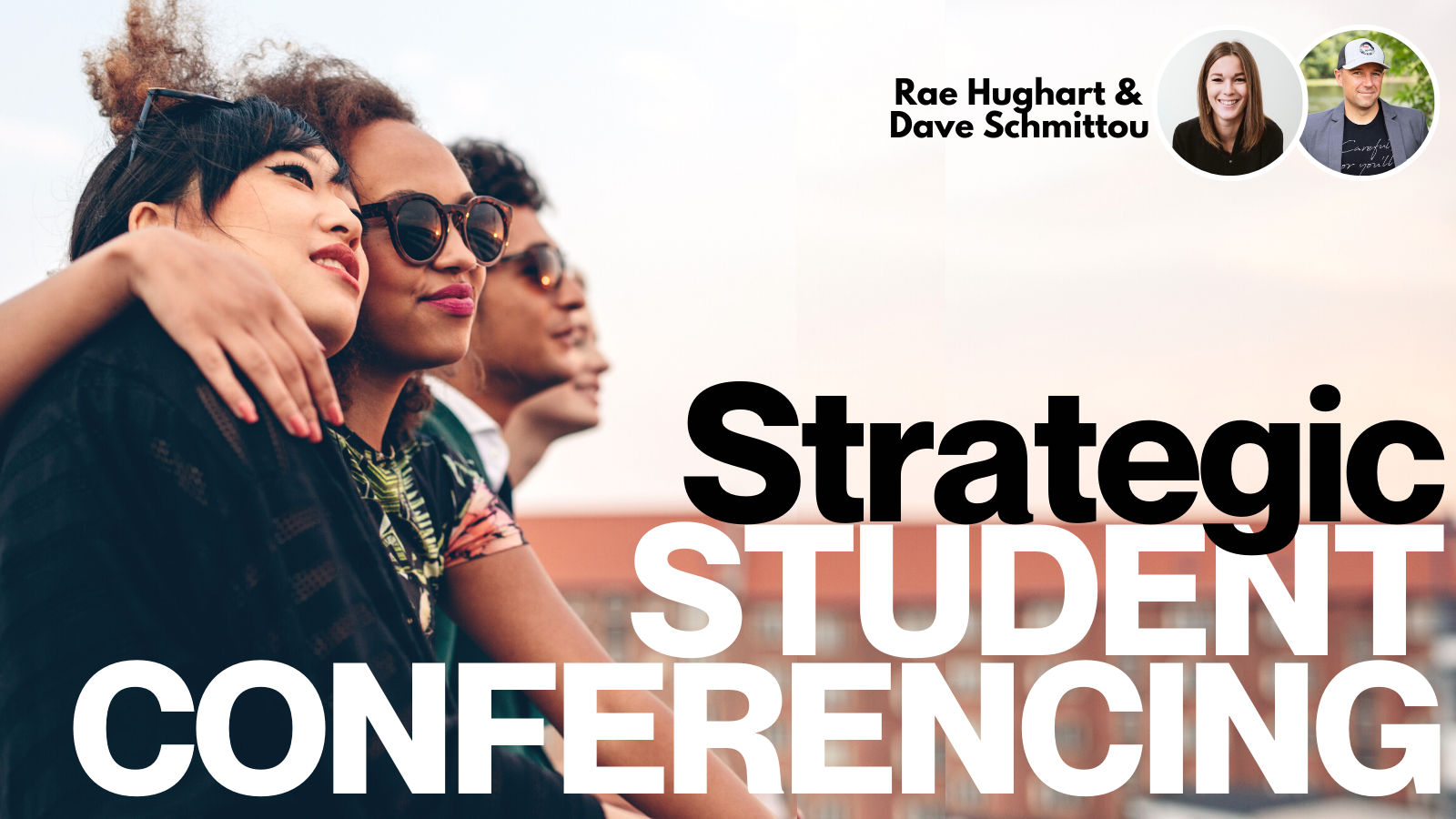
CHECK-INS
LEARNING SURVEYS
- I created a Google Form Learning Survey for both learners and their families inspired by Catlin Tucker. I used similar questions for both because it was important for me to get to know the learners in my classes from both perspectives. This was also a way for me to introduce Google Forms as I have used this digital tool in a multitude of ways. I embedded a welcome video for the families right into the form so they can learn why filling out this form was important to me. This was also a way for me to connect with them, show who I am and what I value as an educator. My learners complete this survey 3x a year so that I can see how their thinking has evolved.
CLICK HERE for Family Learning Survey
CLICK HERE for Student Learning Survey
5-MINUTE MEETINGS
- I schedule five-minute meetings with all of my learners. This idea was inspired by Dr. Mary Hemphill’s book The One Minute Meeting: Creating Student Stakeholders in Schools. The idea of these meetings is to check in with my students, learn more about them as human beings, and then utilize the information to elevate their emotional literacy. There are three simple questions to ask: How are you today? What is your greatest celebration? What challenges have you had recently?
- After asking those simple, open-ended questions and having those personal conversations with each learner, I feel even more connected to each one of them. I now have a deeper understanding of what is happening in their world. Some had really cheerful, positive stories to share, while others were expressing that they are going through challenging times. The responses were collected in Google Forms. This qualitative data is used to drive planning and instruction.
1:1 CONFERENCES
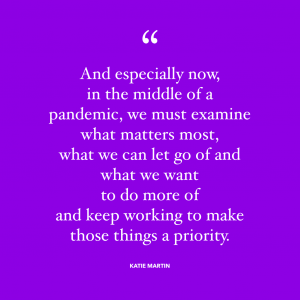
- 1:1 conferencing is a key ingredient to having learners practice, improve, and elevate learning. This sacred time spent with students can be messy as the learner guides the direction the conference will take. The teacher, in turn, should be able to notice and name a learner’s strengths and areas for growth. Then adjust the direction and goals of the conference accordingly. In a conference, the teacher and student are both learners, except, the student is doing most of the work while the teacher coaches and offers thinking prompts to lift the level of the work.
- In virtual spaces, these vital interactions take place in Zoom or Meet breakout rooms. This is a more personalized space to connect, interact, and personalize learning. Katie Martin confirms this in her blog titled, To Engage Students, Focus on Connection Over Content, “Scheduling time with each student to connect, learn more about their circumstances, their goals, and ideas, created a different dynamic that built empathy and allowed for more personalization and meaningful connection.”
About Lauren Kaufman
Lauren Kaufman is a middle school Literacy Specialist and Mentor Coordinator for the Long Beach Public Schools in Long Island, NY. She has served as an elementary Instructional Coach, a 2nd and 5th-grade classroom teacher for the New York City Department of Education, an elementary Reading Specialist, and Creativity Camp Enrichment Program Supervisor. She is a lifelong learner whose professional passion is to empower teachers to lead so they can share their gifts with others and develop lifelong literacy practices in all learners.
Lauren has led teams developing 73 Units of Study in Reading and Writing K-5, has provided educators with job-embedded professional learning that supported a Balanced Literacy approach, and guides new teachers with acclimating to the culture and climate of a school system. She has organized Long Beach Literacy Day and has presented at #LBLit, LIASCD, EDCampLI, NerdcampLI, and DEI Conferences, as well as the Long Island Language Arts Council. Lauren enjoys sharing best literacy practices with colleagues, and wholeheartedly believes in developing powerful professional learning communities that cultivate meaningful, relevant professional growth. 